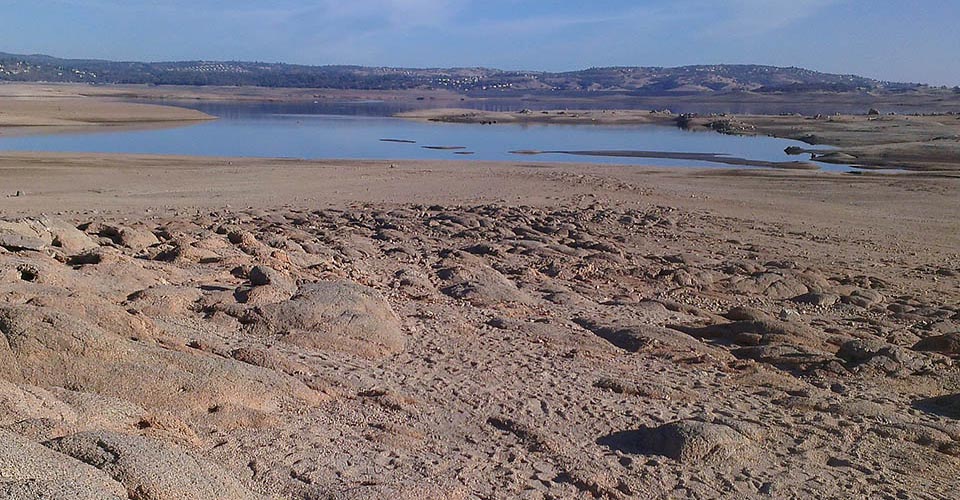
As California’s drought enters its fourth year, more than 70 percent of the state is under extreme drought conditions. Just this week, the California Water Commission announced new lawn restrictions for development projects, limiting grass to 25 percent of the landscape. But such efforts amount to merely a drop in what is already a very dry bucket.

Jeff Bennett is an economist at Australian National University and a 2015 PERC Lone Mountain Fellow. He is also the author of the recent report from the Reason Foundation, How to Solve California’s Water Crisis: Lessons from Australia’s Water Reforms, examining Australia’s experience with water markets.
To learn more, we asked Jeff about water market reforms in the “Land Down Under” and what lessons we can learn to address California’s drought.
Q: With California and much of the western United States reeling from drought, some have pointed to Australia as a model for how to deal with water scarcity. What exactly has Australia done?
A: Australia’s water reforms have centered on the Murray Darling Basin, an area of more than 400,000 square miles in the southeast of the continent. Water in the Basin is used for irrigation and domestic use, but it also supports a wide range of wetland, river, and floodplain ecosystems.
Prior to the 1990s, water uses were heavily regulated by government agencies. The result was an over allocation of water for irrigation as politicians sought political favor from the farm sector and an inflexibility in the ways that water was used. Now, property rights to water have been clearly defined and an active market has emerged in which irrigators trade water rights.
The price of water is determined by the interaction of supply and demand. During a drought, as water becomes increasingly scarce, the price of water increases. In response, irrigators ration their use and invest more in water saving technologies. As the price rises to reflect increasing scarcity, less valuable uses of water are given up. For example, irrigated annual crops are not planted, and only the most valuable uses of water are continued. The process ensures that water is used as efficiently as possible.
At the same time, the over-allocation issue was addressed by establishing and funding an agency to buy back water rights from irrigators. That water is now used to provide “environmental flows” that sustain river ecosystems.
Q: Why did Australia move toward this market allocation of water?
A: The over allocation of the waters of the Murray Darling Basin to irrigation became apparent in the 1980s and 1990s. The lack of water began to cause the loss of wetland areas and forests of River Red Gums along the rivers. Increasing levels of soil salinity caused by excessive irrigation were also of concern. Hence, both farming and environmental groups began voicing their concerns about the management of the water resource.
However, it was the “Millennium Drought” of the 1990s and 2000s that brought the situation to a head. The unprecedented conditions brought about by the drought, on top of the stress already caused by over allocation, triggered widespread recognition that urgent action was required to ensure the survival of both the environment of the Basin and its farming communities.
Q: What have been the results of Australia’s reforms? Has it worked?
A: The market for water rights provides remarkable flexibility in the management of water for irrigated agriculture. It allows farmers to cope more effectively with both seasonal and annual variability in water availability.
The structure of irrigated agriculture is evolving in response to the reforms. Lower-valued uses of water such as irrigated pastures and grains have given way to higher-valued crops such as wine grapes and almonds.
So while the overall amount of water used in irrigated agriculture has declined as a result of the reforms, the value of production has remained relatively stable. In this regard, the reforms worked. The environment of the Basin has begun a ”repair” phase, and the early evidence suggests that wetlands and floodplain ecosystems have recovered—although this is harder to judge given that the reforms have so far been implemented across a sequence of relatively wet years.
Q: What were the responses to Australia’s reforms?
A: The crisis situation brought about by the Millennium Drought created a political context in which change was feasible. However, there were winners and losers from the reform process. Farmers who were freed to either buy or sell water did so because they were made better off by their actions. Buyers have built their enterprises to become more flexible and more profitable despite the higher prices of water. Sellers have either left the agricultural sector, downsized their irrigation operations, become more efficient in their use of water, or converted to dryland farming.
Many Australian farmers required that the reform package be “sweetened” by subsidizing some water conservation investments to ensure that production levels could be maintained. However, these sweeteners were not enough to placate some interest groups in the Basin. Protests against reform were mounted in towns across the Basin, citing concerns that some communities would be threatened by reduced irrigation activity on the surrounding farmlands.
It is true that population has declined in some towns. But these losses have not deviated from long-term trends of depopulation in small communities. Some regions have actually grown with the relocation of water rights and the consolidation of rural populations into larger towns.
Those concerned with the condition of the Basin’s environment have been overwhelmingly supportive of the reforms but continue to advocate for more government spending on the purchase of water rights from irrigators for environmental flows.
Q: What about Australia’s cities? How have they dealt with drought?
A: The water reforms implemented in the Murray Darling Basin have not been mirrored in the allocation of water in Australia’s major urban centers. Faced with supply shortages during the Millennium Drought, water supply authorities in cities such as Sydney and Melbourne resorted to use restrictions and supply supplementation investments.
Restrictions included time-of-day as well as use-type rationing. For example, watering of gardens using fixed hoses was initially restricted to night-time hours and then banned altogether. Major investments were made in desalination plants, and households were subsidized to install rainwater tanks and water-saving plumbing.
With the Millennium Drought now over and water supplies up again, these desalination plants are now unproductive, yet they still place tremendous financial burdens on their cities’ residents because of the need to run them in maintenance mode to preserve their reverse osmosis filters.
The costs of these investments have now been shown to far exceed the benefits they produced. Their impacts could have been achieved at far lower cost through the effective use of price as a means of rationing available supplies among competing uses.
Q: In terms of urban water use, what could be done to promote exchange between higher-value users and lower-value users?
A: The advantages of water trading in the Murray Darling Basin were not experienced by the people of Sydney, Melbourne, and other major urban centers.
People with high values from water use such as gardeners with prize-winning roses were treated just the same as those whose water use was inconsequential. Price was not allowed to act as a signal of water scarcity, and people were not able to react to that signal as they saw fit. Instead, bureaucratic processes dictated what could and couldn’t be done. Rose gardeners, therefore, had to carry buckets of water to their beloved plants, contributing to the emergence of a condition that became known amongst chiropractors as “bucket back.”
This situation could be addressed by allowing urban residents to react to changes in water prices. If the price of water was determined by the level of water in storage, those with high-valued uses of water could simply decide to pay the price while water savings would come from those with low values for water.
Reform would free up trade in water between urban and agricultural users. Given that the value for potable water in urban areas is generally higher than that generated by irrigated cropping, there are potential gains from trade between urban and rural users.
Q: Is Australia’s experience a model for California and other western states dealing with drought?
A: In Australia’s experience, water trading has proven to be a highly effective mechanism for dealing with drought. California and other western states would do well by taking on board the experience “Down Under” as a guide to what could be achieved and how.
The removal of bureaucratic allocation processes and the establishment of water markets in both irrigation and urban contexts would ensure the flexibility needed in drought conditions. Safeguarding the environment through the purchase of water rights from irrigators is also key strategy. It also ensures that irrigators are compensated for the loss of their rights to water.
However, even these environmental allocations should not be removed from the water market. Ongoing trades between consumptive water users and those responsible for environmental flows can be advantageous for all parties.
To read more, see Jeff Bennett’s report “How to Solve California’s Water Crisis: Lessons from Australia’s Water Reforms” at the Reason Foundation.



